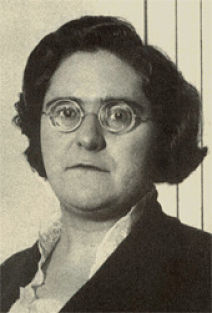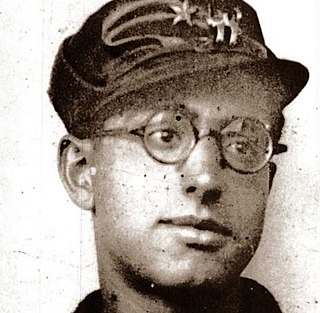Related Research Articles

Federica Montseny Mañé was a Spanish anarchist and intellectual who served as Minister of Health and Social Policy of the Government of the Second Spanish Republic during the Civil War.
Francisco Elías Riquelme was a Spanish film producer. He released the first sound film of Spanish cinema, El misterio de la Puerta del Sol, or The Mystery of Puerta del Sol (1928), which cost 18,000 pesetas at the time.

Ramón Rufat Llop (1916–1993) was a Spanish anarcho-syndicalist, agent of the Republican secret services, and anti-Franco fighter.
The Eastern Army, also translated as the Army of the East, was a unit of the Spanish Republican Army that operated in the eastern part of Spain during the Spanish Civil War. Republican forces deployed on the Aragon front of the war initially came under the command structure of the unit. Later in the Civil War, the unit operated in Catalonia, defending the Republican defensive line along the Segre river.
The 25th Division was one of the divisions of the Spanish Republican Army that were organized during the Spanish Civil War on the basis of the Mixed Brigades. It participated in the battles of Huesca, Belchite, Teruel and Levante.
The 28th Division was one of the divisions of the Spanish Republican Army that were organized during the Spanish Civil War on the basis of the Mixed Brigades. It was deployed on the Aragon and Segre fronts.
The 83rd Mixed Brigade was a unit of the Spanish Republican Army created during the Spanish Civil War from the militarization of the Iron Column. It came to operate on the Teruel, Levante and Central fronts.
The 153rd Mixed Brigade was a unit of the Spanish Civil War that took part in the Spanish Civil War. Formed around the old Land and Freedom Column, the unit took part in the battles of Belchite, Aragon and Segre.
The 81st Mixed Brigade was a unit of the Spanish Republican Army created during the Spanish Civil War. It operated on the Teruel, Levante and Estremadura fronts.
The 94th Mixed Brigade was a unit of the Spanish Republican Army created during the Spanish Civil War. It came to operate on the Teruel, Aragon and Segre fronts.
The 82nd Mixed Brigade was a unit of the Spanish Republican Army created during the Spanish Civil War. It came to operate on the Teruel and Levante fronts.
The 118th Mixed Brigade was a unit of the Spanish Republican Army created during the Spanish Civil War.
The 24th Division was one of the divisions of the Spanish Republican Army that were organized during the Spanish Civil War on the basis of mixed brigades. Throughout the war, the unit was deployed on the Andalusian, Madrid, Aragon and Segre fronts, taking part in some of the main battles.
The XVI Army Corps was a military formation of the Spanish Republican Army that fought in the Spanish Civil War. It had an outstanding performance in the Levante campaign.
The 41st Division was one of the divisions of the People's Army of the Republic that were organized during the Spanish Civil War on the basis of the Mixed Brigades. It took part in the battles of Teruel, Alfambra and Levante.
The 29th Division was a military formation belonging to the Spanish Republican Army that fought during the Spanish Civil War. Originally created in 1937 from the militarization of the POUM militia column, it was dissolved and recreated again in early 1938, operating on the Extremadura front.
The 214th Mixed Brigade was a unit of the People's Army of the Republic created during the Spanish Civil War.
References
- ↑ Foguet i Boreu, Francesc (2005). Teatre, guerra i revolució: Barcelona, 1936-1939 (in Catalan). L'Abadia de Montserrat. ISBN 9788484157236 . Retrieved 22 February 2019.
- ↑ Cobos Guixé, Xavier (2014). El Sindicato de la Industria del Espectáculo de Barcelona (S.I.E. FILMS) i els seus films base (Doctoral Thesis) (in Catalan). Barcelona: Universitat de Barcelona.
- 1 2 3 Juan-Navarro, Santiago (1 June 2011). "Un pequeño Hollywood proletario: el cine anarcosindicalista durante la revolución española (Barcelona, 1936–1937)". Bulletin of Spanish Studies (in Spanish). 88 (4): 523–540. doi:10.1080/14753820.2011.583129. ISSN 1475-3820. S2CID 191595124 . Retrieved 26 February 2019.
- 1 2 3 4 5 Martín García, Óscar (2009). "Celuloide colectivo". icaa - Catálogo de cine español (in Spanish). Retrieved 26 February 2019.
- 1 2 Campbell & Porton 2009 , p. 52
- 1 2 3 4 Crussels, Magí (1998). "El cine durante la Guerra Civil española". Communication & Society (in Spanish). 11 (2): 123–152. Retrieved 22 February 2019.
- ↑ Gubern, Román (1 May 2009). Historia del cine español (in Spanish). Cátedra. ISBN 9788437625614 . Retrieved 22 February 2019.
- 1 2 Martínez Muñoz, Pau (2008). La cinematografía anarquista en Barcelona durante la Guerra Civil (1936-1938) (Doctoral Thesis) (in Spanish). Barcelona: Universitat Pompeu Fabra. hdl: 10803/7526 .
- 1 2 Fama del Olmo, Silvia; Díaz Matarranz, Juan José (2016). "Reportaje del movimiento revolucionario en Barcelona (1936)". Iber (Barcelona). Iber: Didáctica de las ciencias sociales, geografía e historia (84): 81–82. ISSN 1133-9810 . Retrieved 22 February 2019.
- ↑ Caparrós Lera, José María (1981). Arte y política en el cine de la República (1931-1939) (in Spanish). Edicions Universitat Barcelona. p. 177. ISBN 9788485411481 . Retrieved 26 February 2019.
- 1 2 Campbell & Porton 2009 , p. 53
- 1 2 Campbell & Porton 2009 , pp. 53–55
- 1 2 3 4 5 6 7 Crusells, Magí (2001). Las Brigadas Internacionales en la pantalla (in Spanish). Univ de Castilla La Mancha. ISBN 9788484271499 . Retrieved 22 February 2019.
- 1 2 3 Cabeza San Deogracias, José (1 January 2005). El descanso del guerrero: cine en Madrid durante la Guerra Civil española (1936-1939) (in Spanish). Ediciones Rialp. pp. 79–80. ISBN 9788432135446 . Retrieved 22 February 2019.
- ↑ Caparrós Lera, José María (1977). El cine republicano español: 1931-1939 (in Spanish). Dopesa. ISBN 9788472353039 . Retrieved 22 February 2019.
- ↑ Comas, Ángel (17 January 2017). Emisora Films, studio system en el primer franquismo. Penguin Random House Grupo Editorial España. ISBN 9788491129790 . Retrieved 22 February 2019.